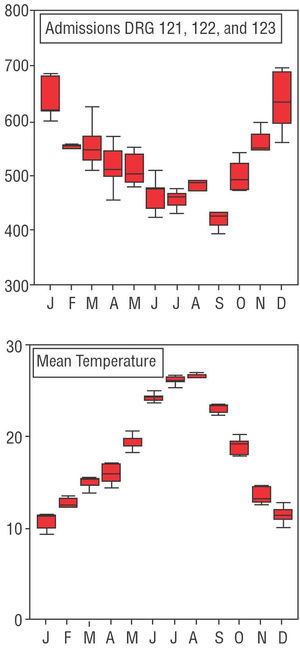To the Editor:
Further to the study by González Hernández et al, which is an extension of the PRIMVAC study,1 we feel you might be interested in the results of a similar study concerning seasonal variations in acute myocardial infarction which was undertaken over the 5-year period of 1998-2002 in the autonomous region of Andalusia. We reviewed the minimum basic data set of the 33 hospitals belonging to the Andalusian Heatlh System (AHS), which provides specialized assistance and care to a population, in 2002, of 7 013 295 persons. Of a total of 2 787 008 episodes of admission, 837 665 were for non-surgical reasons, of which 31 230 corresponded to Diagnosis Related Group (DRG)2 121: circulatory disorders with acute myocardial infarction, cardiovascular complications, discharged alive, 122: circulatory disorders with acute myocardial infarction, no cardiovascular complications, discharged alive, and 123: circulatory disorders with acute myocardial infarction, expired.
The median number of monthly admissions was 13 927.5, of which 518.83 were for acute myocardial infarction. The overall mortality rate was 7.32% and that corresponding to the selected DRG was 14.20%.
We detected a clear seasonal variation in the episodes corresponding to DRG 121-123, which is clearly depicted in Figure 1. This figure also shows the absolute parallelism with the mean temperatures in Andalusia during the same period. The Student t test for comparison of means showed no significant monthly differences in mortality rates for acute myocardial infarction between 1998-2002, whereas the overall mortality rate did vary for admissions for all non-surgical causes, which were significantly higher (P<.0001) during the colder months (November, December, January, and February) compared with the warmer months (June, July, August, and September). Likewise, and applying the same statistical test, we found statistically significant differences when we compared the number of admissions for acute myocardial infarction between the same groups of months.
Figure 1. Box chart (median, 25th percentile, 75th percentile, and distribution limits) representing the evolution of episodes of admission for Diagnosis Related Groups (DRG) 121, 122, and 123 in the network of hospitals belonging to the Andalusian Public Health System and the mean temperatures in Andalusia in degrees centigrade (source: INE) during the period 1998-2002.
As the PRIMVAC researchers mention, the seasonal rhythm of admissions for acute myocardial infarction has been well established, as has their very likely association with heat stress. To a certain extent this is reinforced by our data obtained from almost all ischemic cardiac diseases in a region such as Andalusia, in which temperatures may vary by more than 18oC between summer and winter. However, changes in mortality due to this cause are not reflected in our data either, not even when compared by month, season or hot or cold period, in spite of the fact that small differences in such high volumes of cases are usually statistically significant.
ACKNOWLEDGEMENTS
The databases analyzed were ceded by the service of the Producto Sanitario de la Subdirección General de Asistencia Especializada del Servicio Andaluz de Salud. We are specially grateful to María R. Jiménez Romero for her valuable collaboration.


